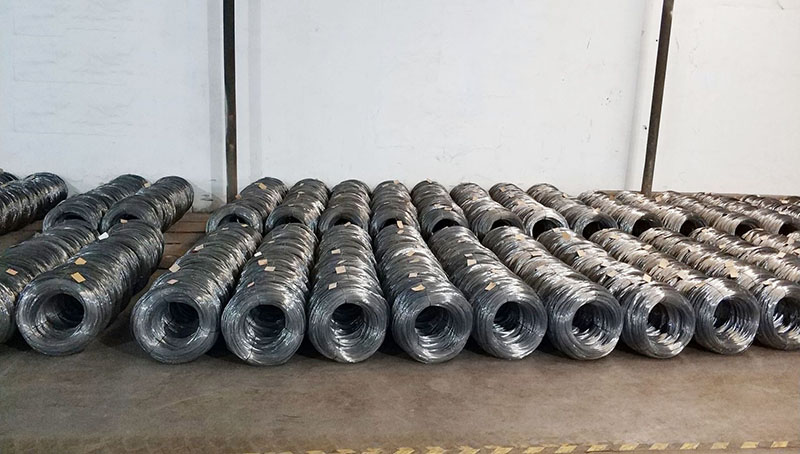Black Iron Wire: An Unassuming yet Versatile Metal Wire

Across industries such as industrial production, construction, and daily life, there is an apparently ordinary yet indispensable metal material—black iron wire. With its plain black appearance and flexible performance characteristics, it silently undertakes a variety of practical functions, becoming an irreplaceable "all-rounder" in people's production and daily lives.
Black iron wire gets its name from the natural black color of its surface, a visual feature that also directly reflects the nature of its material. Its core raw material is high-quality low-carbon steel, with iron as the main component, supplemented by small amounts of trace elements such as carbon, cobalt, nickel, copper, and zinc. The presence of these trace elements not only ensures the basic strength of the material but also does not excessively affect its processability. The selection of low-carbon steel endows black iron wire with inherent good plasticity, laying a foundation for subsequent multi-specification processing and multi-scenario applications.
From metal billets to finished wire rods, the production process of black iron wire embodies precise industrial logic. First, red-hot metal billets are rolled into thick steel bars with a diameter of 6.5mm, known in the industry as "wire rods"—the basic raw material for wire processing. Subsequently, the wire rods are fed into professional wire-drawing equipment, where they are drawn into thin wires of different diameters by gradually reducing the aperture of the wire-drawing die. During the wire-drawing process, key processes such as cooling and annealing are also required: the cooling process ensures stable forming of the wire, while the annealing process can flexibly adjust the hardness and softness of the iron wire. After annealing, black iron wire becomes softer and more flexible, capable of adapting to complex processing needs such as bending and winding.
The diversity of specifications is a key reason for the wide application of black iron wire. Its specifications are marked by "wire gauges," covering multiple models from 5# to 38#, with corresponding wire diameters ranging from 0.17mm to 4.5mm—meeting the differentiated needs for wire thickness in different scenarios. Among them, thick wires such as 8# (4.00mm) and 10# (3.50mm) are often used for load-bearing or fixing purposes due to their high strength; medium and thin wires such as 14# (2.03mm) and 20# (0.90mm), with their excellent flexibility, are the first choice for daily processing and precision operations.
In terms of performance, black iron wire has distinct characteristics. In addition to its rough, lusterless surface and natural black color, its corrosion resistance is relatively weak—it is prone to oxidative rusting in humid environments, which is a key point to note during use and storage. However, its advantages are equally prominent: good elasticity allows it to recover its shape to a certain extent after being stressed; excellent flexibility enables it to be easily bent and wound without breaking. Moreover, through adjustments to the annealing process, it can strike a balance between "hardness" and "softness," adapting to the needs of different processing scenarios.
For the convenience of transportation and storage, the packaging of black iron wire is also carefully designed, with two common methods: "inner plastic + outer hemp" and "inner plastic outer woven bag." First, a thin layer of plastic film is wrapped around the wire to provide basic protection against moisture and abrasion; then, the outer layer is wrapped with hemp bags or woven bags to enhance the firmness of the packaging. This prevents the wire from loosening or deforming during transportation and also facilitates subsequent handling and use.
From construction sites to garden courtyards, from industrial production to daily necessities, the application scenarios of black iron wire are widespread in all corners of life. In the construction industry, thick-specification black iron wire is a capable assistant for binding steel bars and building scaffolding, ensuring the stability of the construction process with its strength. In horticulture, it can be transformed into the framework of flower stands or used to bind the branches of seedlings, helping plants grow in an orderly manner. In daily life, it is the core material for making clothes hangers and drying racks, and an ideal choice for handcraft enthusiasts to create iron art crafts—from small exquisite wire ornaments to large practical home decorations, its presence can be seen everywhere. Additionally, in warehousing and logistics, it is used for binding goods, and in agricultural production, it is used for fixing shed frames, fully demonstrating its practical value of "one thing with multiple uses."
Although black iron wire has relatively weak corrosion resistance, its service life can be effectively extended by taking moisture-proof measures during use—such as storing it in a dry environment and applying anti-rust coatings when necessary. This unassuming yet practical metal wire, with its affordable cost, flexible performance, and wide range of applications, has become a well-deserved "unsung hero" in industrial production and daily life, always playing an indispensable role in ordinary positions.
![]() 中文
中文

